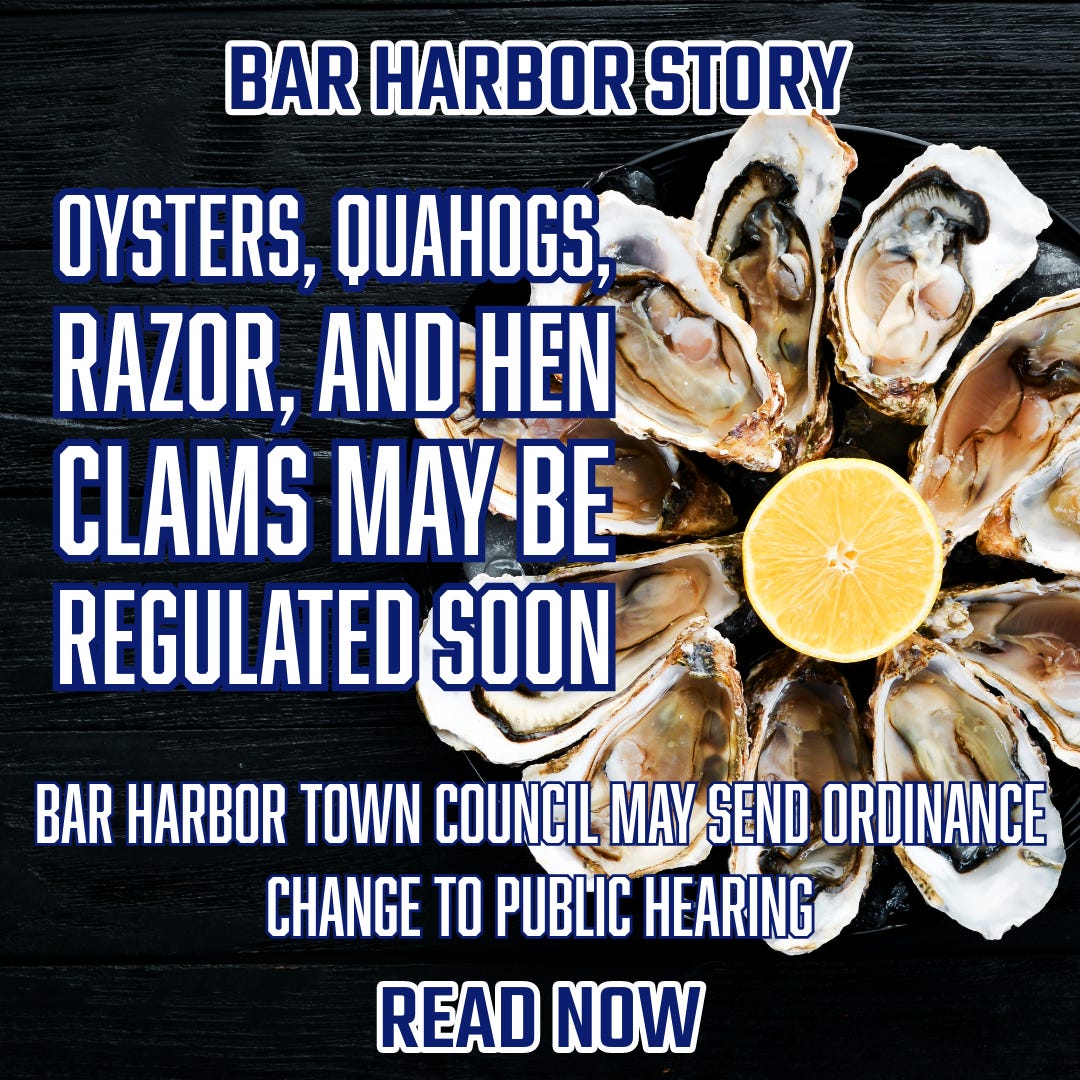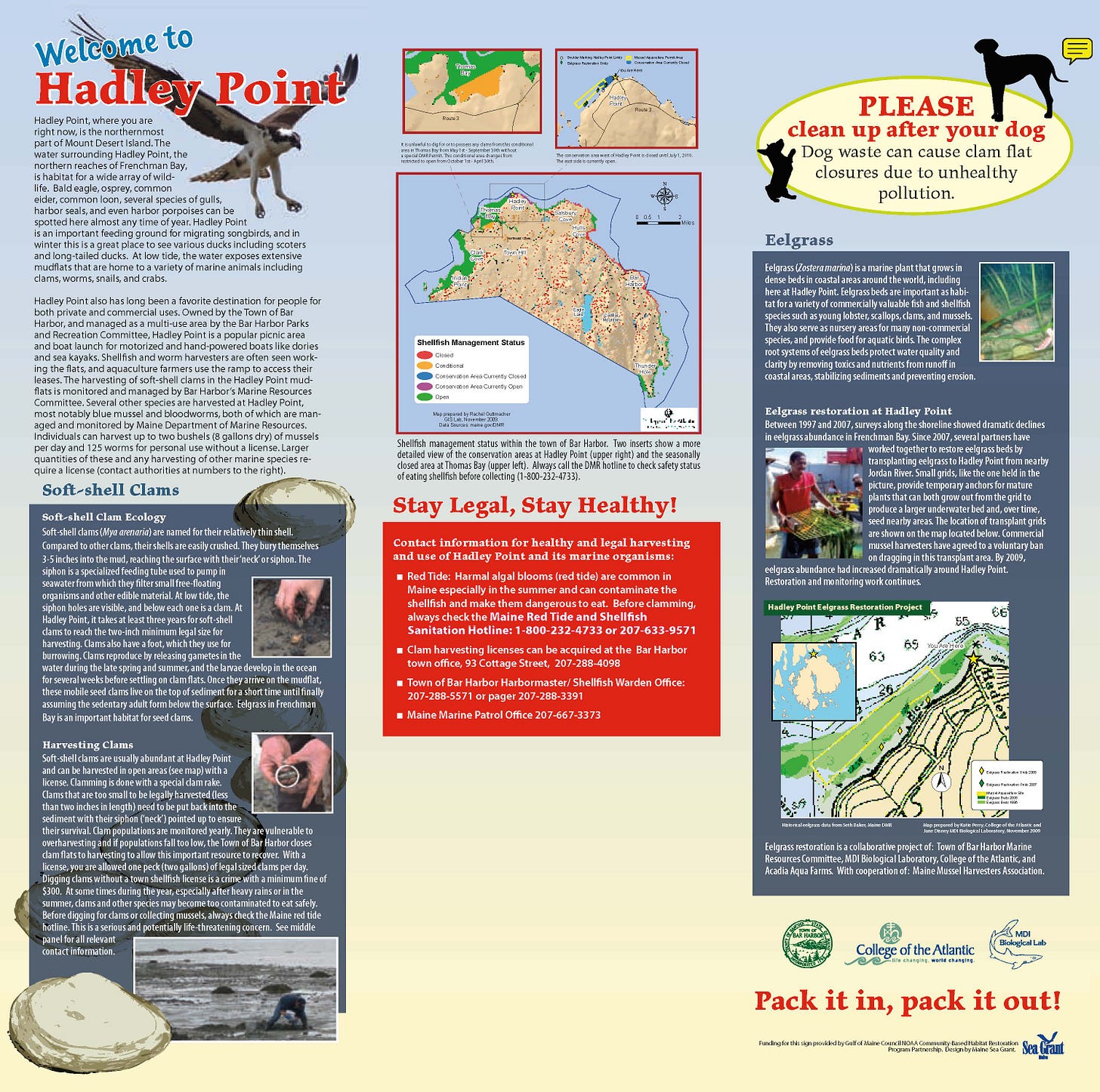Oysters, Quahogs, Razor, and Hen Clams May be Regulated Soon
Bar Harbor Town Council may send ordinance change to public hearing
BAR HARBOR—The Bar Harbor Town Council may send potential changes to the town’s shellfish ordinance to public hearing Tuesday night.
If the ideas stay true to the February 28 and March 20 Marine Resources Committee meetings and the changes are approved by the Town Council, then the town would:
Add hen(surf) and razor clams, oysters, and quahogs to the BHMRC ordinance, setting the recreational harvest limit to a 1/2 bushel for hen clams and a peck for a mix of the other species, including soft shell clams.
Change the commercial non-resident harvester amount of 10% resident licenses to unlimited and apply to the Maine Department of Marine Resources to designate Northwest Cove and Clark Coves as conservation areas in order to set a one-bushel limit on quahogs for commercial diggers in those coves.
The seven hours conservation time will currently remain for both resident and non-resident commercial harvesters. According to the Bar Harbor ordinance, “Qualifying conservation time includes attending Marine Resources Committee meetings, clam flat population and recruitment surveys, reseeding and any other approved activity. Any member of the Bar Harbor Marine Resources Committee may verify hours for approved activities.”
The current state recreational limits for quahogs, razor clams, and oysters is one peck a day. The state limit for hen or surf clams is three bushels a day. A peck is about half a six-gallon bucket. There are four pecks to a bushel, so a bushel is approximately two six-gallon buckets.
Bar Harbor has more than 100 recreational licenses each year.
The changes would also allow oyster harvesting in the summer, which according to a statement sent by Chair Chris Petersen to papers in February “will otherwise be prohibited by the state starting in 2024.”
The committee members had decided to raise conservation time hours from 7 to 12 in 2025 for licenses, but were concerned about license allocations after much public comment from David Dunton, Victor Doyle, Brian Silverman, Rusty Taylor, and others at its last meeting.
While the license allocation question was tabled until April, the group passed changes to the ordinance as proposed without the additional conservation time requirement for now.
The goal of the ordinance changes is for the town to regulate the newly protected species and Mya (soft-shell clams). That said, the committee doesn’t want to exclude commercial harvesters who are not residents completely. Finding a balance between protection and livelihoods has been a recurrent theme in the committee’s work for its last few meetings.
One of the committee’s goals is to make sure that the town’s two shellfish wardens would have the ability to engage with harvesters about those four species that are not regulated currently. The need to educate is especially true for recreational harvesters who mostly dig in July and August.
If quahogs, razor clams, eastern oysters, and hen clams are not in the town’s ordinance, the wardens can’t educate people about them and can’t keep people from wiping out an area by overharvesting.
State law gives towns three licensing options: 10% of commercial resident license holders; unlimited; or a set limit. When there is a set limit, if the town has any unsold licenses after 90 days, they become the state’s purview. When that happens, the town can no longer require conservation hours from the applicant.
“We all want the resources to do well but don’t want to underestimate the pressures of people trying to earn their living,” Fiona de Koning said.
As the draft minutes for the meeting express, ”The Chair asked MRC members to offer opinions. After discussion, it was clear that members wanted to offer non-resident commercial licenses, but felt trapped by not being able to limit the number of harvesters to avoid over-exploitation of Bar Harbor’s shellfish, while also insuring that conservation hours are part of the licensing requirements. Committee members felt that having harvesters work along with them to manage the resource fosters trust and information sharing, which helps in future management. It also became clear that the MRC is trying to make a decision without full knowledge of numbers of non-resident harvesters active in Bar Harbor and what the full shellfish resource is in all of Bar Harbor’s shoreland.”
Dunton espoused upon a litany of loss: shorelines that have never recovered, green crabs that have devastated populations, harvesters who take far too many clams, bridges built, roads, landscapes changing.
“It’s becoming a lost way of life,” Dunton said. “In 2022 we had enough to support three commercial harvesters in this town. I don’t believe we have the resources to keep me going, let alone another harvester.”
A 1989 Ellsworth American article by Steven Rappaport detailing the reseeding efforts in Kings Creek clam flats, said, “Only one fisherman, David Dunton of Bar Harbor, joined the group to assist in the transplanting effort. He is one of only four or five active commercial clam diggers on the island, according to Ben Baxter, University of Maine extension agent.”
Committee Chair Chris Petersen said that green crabs have been devastating some shellfish. Dunton also said over harvesting in some areas and poaching was impacting the stock.
The Town Council meeting is April 2, beginning at 6:30 p.m. at the Bar Harbor Municipal Building.
LINKS TO LEARN MORE
The proposed state changes at www.maine.gov/dmr/rules-enforcement/regulations-rules/proposed-rulemaking (Chapters 4, 7 and 115)
The town’s current license page.
The Bar Harbor Marine Resources Committee page.
Committee’s Chapter 170 Shellfish Conservation
Bar Harbor’s 2023 Shellfish Management Plan
Maine’s Municipal Shellfish Management Manual
Community-based eelgrass (Zostera marina) restoration in Frenchman Bay by Jane Disney and George Kidder. A 2010 Mount Desert Island Biological Bulletin paper on an eelgrass restoration project initially funded by a Gulf of Maine Council grant written by the marine resource committee.
Do current recruitment enhancement methods increase juvenile soft-shell clam (Mya arenaria) recruitment in an intertidal clam flat? is a 2009 report that was part of a College of the Atlantic student senior project by Sarah Drerup.
Resource management in a small Maine town: monitoring, conserving, and managing clam flats in Bar Harboris a 2007 report that was the basis of a College of the Atlantic student senior project by Kipp Quinby.
Clam surveys and management in Bar Harbor is a 2003 report by College of the Atlantic students Kipp Quinby and Nina Therkildsen.
Bar Harbor Mussels In Danger
CARRIE JONES FEBRUARY 17, 2023
How Did That Get In The Water?
CARRIE JONES FEBRUARY 18, 2023
After Giving Up Hope, Local Man Spreads His Clam Seed
JULY 20, 2023











